For whatever reason, I watched a lot of “Press Your Luck” as a kid. The Whammy animations are pretty annoying now that I’ve had the pleasure of playing the DVD version of the game recently, but I guess back then I was easy to please. The show involved players earning money by pressing a button and having the choice keep going or walk away with what they’ve won lest they stop their selection on a Whammy, in which case they lose everything.
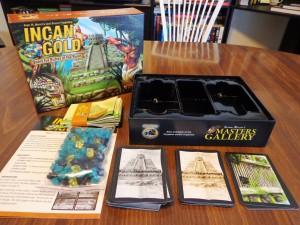
Incan Gold: 3-8 Players*, Ages 8+, Average Play Time = 20-40 Minutes *2 Player Variants Available (Though Not In The Manual)
Incan Gold is very similar to this mechanic, except without the cheap 80’s animations that took five minutes to play out every time someone landed on a Whammy. Players will be exploring an Incan temple in an attempt to walk away with riches and artifacts. Along the way, they’ll be running into hazards that will force them to run out of the temple, dropping everything they’ve collected in the process. The player who can “press their luck” the most and succeed will walk away with the most riches and win the game. Let’s take a quick look at the game and how it’s played before we head into the review.
Components
Cards – These make up the bread and butter of the game, consisting of Temple cards (numbered one through five), Player cards (Torch and Camp cards), Quest cards (Treasure and Hazard cards), and Artifact cards.
Treasures – Also referred to as gems…these pieces are given to players as they are earned throughout the game.
Tents – Each player will have a tent. Any gems that they’ve been allowed to keep permanently are placed inside for endgame scoring.
Setup & Gameplay
Each player gets one torch card, one camp card, and a tent. The temple cards are laid out and an artifact card is placed under each. The quest card deck is shuffled and the first player is chosen randomly.
The game is played over five rounds. Each round, all players will enter the temple and decide after each quest card drawn if they want to continue by choosing either the torch card (to keep going) or the camp card (to head back to camp). Players who choose to go back to camp can keep all of the treasures they’ve collected, plus any artifacts or leftover gems that remain on the path of quest cards behind them. Once a player chooses to go back to camp, they are done for that round and cannot re-enter the temple. If at any point two of the same hazard card appears, any players who are still exploring are forced to run back to their camp and lose everything they’ve collected. An artifact card is shuffled in to the quest card deck each round and are worth points to the person who picks them up after playing the camp card, should they appear. The person with the most points (gems plus artifacts) after five rounds wins!
There’s a bit more to it than that, but the above overview should give you an idea of what the game is like and if it’s something you’d be interested in. I couldn’t find a manual on the Gryphon Games’ website, sorry! If you have questions, feel free to ask them in the comments below.
The Review
I usually don’t take to luck based games, but this one appealed to me anyway. The components are well done and nice to look at, giving that Indiana Jones-esque feel that we all know and love (at least, I do). Learning the game was pretty easy, once I got used to what all of the different cards did and how they interacted with each other.
While the game is heavy in luck, there are still things to take into consideration when deciding on whether or not you should (or shouldn’t) keep going. When treasure cards are drawn, the gems are split between all of those still exploring the temple with the remaining leftovers placed on the cards to be picked up on the way out. Players may want to book out early even if only a hazard or two have appeared, just to collect on artifacts that may be available. It’s worth noting that if two players leave at the same time voluntarily, they don’t get to pick up any artifact cards on their way out. However, the more people who leave, the more those who have stayed receive when treasure cards are drawn. Being the only one left and drawing treasure cards can really push someone into the lead.
My son Vinnie (11) and I played a two player variant and we both had a lot of fun. The first game we played was very short, as we got kicked out of the temple the first few rounds after drawing only five quest cards. We had earned nothing until about the fourth round, with Vinnie pulling ahead in the fifth round. The hazards were particularly nasty in that first game. The second game was a lot better and we got to see a lot more of the treasure cards. The pre-programmed bot that filled in for our third player helped to keep things balanced, neither Vinnie nor myself pulled ahead of the other until the last round.
Overall, this is an excellent diversion and would make a fun filler in between longer play sessions. It would also do well on family game night, assuming everyone is in the mood for a “Press Your Luck” kind of game.
Final Verdict: 6/10
—

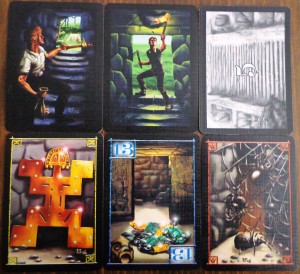
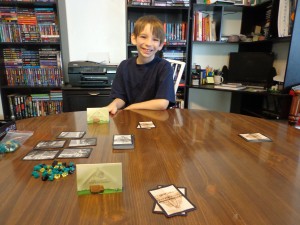
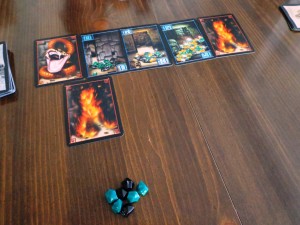
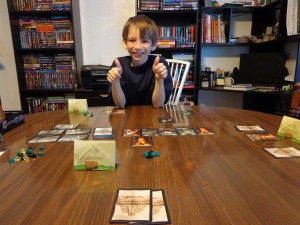
Hi,
Luv the picture! So, does the boy still want to play it, that’s my question. I need a game for my two boys, 7-1/2 and 9. They are not really into board games too much. They play forbidden island & tonga island. Having trouble finding a game that want to keep playing. It seems after a couple weeks they just put it on a shelf and go back to Legos.
Thanks!
Hi Lisa,
The kids do enjoy playing it from time to time, though it’s worth noting that we receive a ton of games to review so they don’t have a lot of time to spend on any one game. Incan Gold is a great press-your-luck game, if your kids like random chance. On the other hand, Blokus and Tetris Link are both good strategy games if they like to think a bit and both are relatively easy to find if you can’t order online.
As far as having a short attention span, kids will do that…LOL. They go through their phases and get addicted to one thing and stick with it for a while and ignore everything else. Legos are a big hit around here as well.
If they have any video game system and they are allowed to play them, the Lego games (Lego Star Wars, etc.) are fun too, if you’re looking for holiday gift ideas.